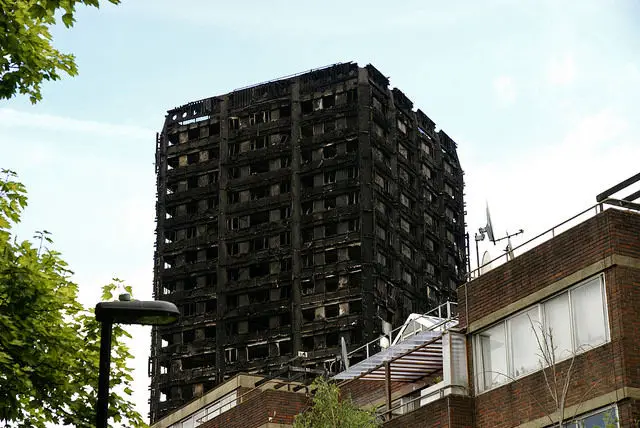In light of the horrific Grenfell Tower fire – where dozens of residents have already been confirmed dead and many more still missing – OnTheWight has had several readers get in touch concerned about the possible risk of combustible cladding on Isle of Wight buildings.
Happily the Isle of Wight doesn’t have many tall buildings – it’s one of the charms of the Island – however, concern has been raised about buildings where responsibility lies with public bodies such as the Isle of Wight NHS and Isle of Wight council.
Vectis Housing Group were able to provide swift reassurance (see below), but the Isle of Wight council less specific and we’re still waiting for the NHS Trust.
Survey of buildings
Not specifically asking about tower blocks, last week OnTheWight posed the following questions to the IWC and NHS:
- Could you confirm whether IWC/NHS has carried out a survey of cladding on all buildings used by IWC.
- Are you reassured the cladding used on all buildings used by IWC/NHS meet safety guidelines?
- Is any of the cladding Reynobond? If so what type? Is it PE?
Council response
Since the Grenfell Tower fire, the focus across the country has been to evaluate the cladding on buildings over six storeys.
That’s because this is the point at which it becomes more difficult for the fire service to rescue those inside whilst a fire is ongoing.
Although we didn’t focus on six storeys, it’s the information the IWC replied with.
A spokesperson for the Isle of Wight Council told OnTheWight,
“Fire safety investigations undertaken this week, confirm that no six storey buildings on the Island are clad in Aluminium Composite Material (ACM).”
Cladding on other buildings
That’s good news for any of the buildings that might be over six storeys (we can’t think of many on the Island, but have asked the council for clarification), but it doesn’t address our specific questions.
The Reynobond PE cladding that was used on Grenfell Tower – and now it emerges on many other buildings across the country – has been reported to be highly combustible and therefore whether a building with that cladding is two storeys or ten storeys, the risks associated with it will still be of concern.
We went back to the IWC asking for our specific questions to be answered, and have been told they expect to provide an answer later today (Monday) or tomorrow.
To OnTheWight, given the anxiety that may be felt by those living or working inside clad buildings, this seems a rather relaxed response.
Housing Associations
OnTheWight also contacted three housing associations on the Island; Vectis Housing Association, Southern Housing Group and Spectrum.
Martyn Pearl, Chief Executive of Vectis Housing Association, was impressively quick to respond. He said,
“VHA have no stock over three storeys high and have not used cladding panels of the type receiving the current investigation. Any cladding materials we have used on our low rise blocks are of traditional and non-flammable materials. We do have a rigorous health and safety and fire inspection regime for all our communal areas.
“I will be looking to reassure our tenants in a forthcoming newsletter we will be distributing shortly.”
A spokesperson for Southern Housing Group told OnTheWight,
“We don’t have any cladding on any of our blocks on the Isle of Wight. None of our blocks on the Island are over six storeys tall.”
Tim Abbott, Head of Corporate Affairs, Sovereign (Spectrum Housing) told OnTheWight,
“Sovereign do not own or manage any buildings of six-storeys or over on the Isle of Wight.
“We have no buildings, of any height, on the Isle of Wight with cladding made from the Aluminium Composite Material (ACM), the type of which was found on Grenfell Tower.”
He went on to say,
“Following the tragic events at Grenfell Tower, we can reassure residents that their safety is our highest priority. We have robust measures in place to make sure all of our properties are safe, working closely with the fire authorities. Our buildings meet all safety and fire regulations and we carry out fire risk assessments every year to make sure our supported schemes, flats and other communal areas remain safe.
“However, we understand residents may be worried so we’ve stepped up inspections by our housing teams to both provide reassurance and to make sure fire safety practices are being followed, such as keeping fire doors closed and communal areas free from rubbish. If any residents have any concerns, they can get in touch with us online, call us on 0800 988 4858 or find us on Facebook.”
NHS still investigating
The Isle of Wight NHS Trust weren’t able to give an answer either and when we re-prompted them this morning, they indicated they’re still looking into the situation.
Update: Independent review of cladding on St Mary’s Hospital to be carried out
IWC: Working closely with the Fire Service
The Isle of Wight council spokesperson added,
“The council work closely with the Fire Service to ensure that we take appropriate measures to reduce fire risk in our buildings, through initiatives such as fire alarms and sprinklers. The council’s building control service also has a role in advising and regulating new buildings.
“There are no council owned high rise buildings on the Island (over six storeys), and the council owns no ‘council housing’ stock.
“The Fire Service also works with businesses and building owners to advise on measures to reduce fire risk and ensure compliance with the Fire Safety Order. It is, however, building owners who own the risk and are ultimately responsible for their building(s).
“Our teams are proactively working with representatives across the Island presently, to advise as appropriate in the wake of the Grenfell Tower disaster.”
Article edit
Comment from Spectrum Housing added 16.50





